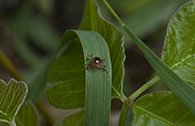Tick-caused bobcat fever can be deadly to domestic cats
Monday, June 24, 2013
MANHATTAN -- Kansas State University veterinarians are warning pet owners to watch out for ticks carrying a disease that could kill cats.
Cytauxzoon felis, also known as bobcat fever, is a blood parasite that infects domestic cats and has a very high death rate. Susan Nelson, a veterinarian and clinical associate professor at Kansas State University's Veterinary Health Center, says this disease was thought to be carried only by the American dog tick, but now may be carried by the lone star tick, which is quite prevalent in northeast Kansas.
"Most people have probably seen a lone star tick even if they're not familiar with them by name," Nelson said. "They're the ones that have a bright white spot on their back."
Bobcat fever does not affect humans or dogs. It is called bobcat fever because bobcats are considered the main reservoir for the disease, as it is typically not fatal for them.
Most cases of bobcat fever occur from March through September, which coincides with the times cats are most likely to encounter ticks. Late spring and early summer are the peak times for ticks in Kansas.
Nelson says cats that live outside the city boundaries are at a higher risk of getting bobcat fever because they are more likely to encounter ticks in a rural environment; however, that doesn't necessarily mean that your city-living kitty can't get the disease. If your cat has contracted the disease, it can be anywhere from five to 20 days before symptoms appear.
"First, you're probably going to notice they're going to be really lethargic and tired," Nelson said. "Their appetite is going to decrease. They may feel very hot to you as they will tend to run a high fever early in the course of the disease. As the disease progresses, you might see breathing problems, dehydration and the whites of their eyes or the inside of their ears might start looking yellow as they start getting jaundiced. Their body temperature will start to drop as they near the end stages of the disease."
A cat may be infected even if you don't see a tick on the animal, because the tick may have already fed and dropped off the cat before the animal starts showing symptoms of the disease.
No vaccine is available for this disease. Treatment can be expensive and often unsuccessful, so it is important to take precautionary steps to keep your cat from being bitten. Nelson says the best thing to do is to keep your cat indoors. If you can't do that, then keep your yard well maintained — it's a myth that ticks from fall from trees.
"If your cat likes to stay in the yard, try to keep your grass mowed down so it's not tall," she said. "The ticks tend to like the taller grasses. Keep the shrubbery trimmed short and remove debris around your house. Do daily tick checks on the cats and remember to look between their toes. If your cat lives with a dog, make sure you are using some type of tick control on the dog as it can bring ticks into your house, which can then feed on your cat."
Nelson also suggests talking to your veterinarian about types of tick control medications to determine which is best for your pet.
Tick expert Michael Dryden, university distinguished professor of diagnostic medicine and pathobiology at Kansas State University, tracks the lone star tick and says they are mainly found in eastern Kansas and in the Southeastern states. So far, he has not found any lone star ticks west of Clay Center, Kan., but he expects its territory will expand.

